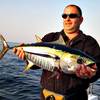There is a variety of fish species that one can target and they are found in different locations and you need different methods to target them. I am going to list the most common species that are targeted but there are more and then we also have Marlin which is a subject on its own.
Remember that this is just a guideline and the fish do not read these articles, so anything can happen out there and it does.
Queen Mackerel (Natal Snoek) Season - All Year
Usually found near backline until about 15m depth near the surface to mid-water.
King Mackerel (Couta) Season - Autumn
Usually found from 10m 30m depth from the bottom till mid -water.
Wahoo (Also a Mackerel) Season - Spring to Autumn
Usually found from 30m to 150m depth in sub surface water.
Yellowfin Tuna All Year but difficult in winter
Usually found from 30m to very deep water over 1000m from the surface to the depths.
Eastern Little Tuna All Year
Usually found from Backline to 400m depth near the surface to mid-water.
Oceanic Bonito All Year but difficult in winter
Usually found from 100m depth to very deep water on the surface and sub surface.
Dorado Season Summer
Usually found from 30m to deep water
Sailfish Season All year but difficult in spring
These can be found anywhere as they move from the shallows to the deep.
Other species are King Fish, Yellow Tail, Amber Jacks, Prodigal Son, Garfish, and Sea Pike etc.
Lure trolling is not a hap hazard way of fishing and if you think you going to go out on and pull a lure behind the boat your results will be dismal. Lure trolling requires teamwork and each rod requires its position and the lures need to be set in the right positions. You can troll anything from 2 9 lures at a time but it is best to work with 4 or 5 rods at once. For this article I will focus on 4 lures at a time as this is reasonably basic and easy to manage and a good place to start.
Trolling 4 Lures without outriggers
Here you can divide your boat in 2 halves and each side will work the same with 2 rods per side. 1 rod pointing out the side and 1 rod pointing back, it is important that the side rod's tip is at least 300mm higher that the back rod, on the other half of the boat you do the same. Most boats have trolling boards with 4 rod holders which can tilt so the side ones are tilted up at around 15-30 degrees and the back ones are flat parallel with the deck. This will also mean that the lures on the side rods which have higher tips will always be further back than the back pointing flat rods, this is to ensure you do not get tangles especially when you need to turn. The lures on the side rods that are further back must always be let out first and then you let out the lures on the back rods.
It is important to note that the fish are not scared of your moving boat and that they are in fact attracted to the prop wash and wake, and so letting lures out 100's of meters behind the boat will achieve nothing. You need to use your boat as a mobile FAD (Fish aggregating device) and place your lures in key areas that the fish are attracted to.
The 2 back lures need to be on the sides of your prop wash, and the 2 side lures need to be in you wake. Typically the side lures would be 25-30m back from the boat and the back lures 15-20m from the boat. It is also better to place the larger lures closer to the boat and the smaller ones further back.
There are a variety of lures that one can use to troll which I already covered in my article "Trolling Dynamics for small Ski Boats" and one can use combinations of these lures.
A nice general spread would be a combination of skirted lures like Feathers or Kona's on the side lures and Lipped hard plastic lures like Rapala's on the back lures as most of the fish above would go for these and so you would have a better chance of catching what ever is around. You can run smaller ones closer to shore and larger ones deeper out. Wahoo like deeper run lures and Couta like very deep runners, Snoek, Dorado and Sailfish prefer surface or sub surface lures and the Tuna Species will go for any of them.
Couta and Snoek prefer slower speeds of 6-8km/hr whilst Dorado, Tuna and Sailfish prefer then a little faster at 8-15km/hr. Wahoo like it fast.
Rapala type lures will be limited to a maximum of 10-12km/hr, see my article "Rigging up for Trolling Part 1" for more detail on setting up your Rapala's. Feathers and Kona's can be trolled much faster.
When trolling on the backline zig zag from the back wave to 10m and back as you go along, for deeper waters pull over pinnacles, reefs, ledges and contour lines, look for birds, debris, scum lines, current lines etc.
When out there you will encounter conditions where you have to go into the swell which is most uncomfortable and here it is better to zig zag keeping the boat on the quarter bow. When dealing with a following sea you will find that you accelerate and slow down which is no good and so again zig zag keeping the boat on the quarter stern. When it is flat or you are riding beam sea straight trolling will be OK although I do prefer directional changes with a light zig zag pattern.
Be prepared as with these methods you will often get multiple hook ups.


